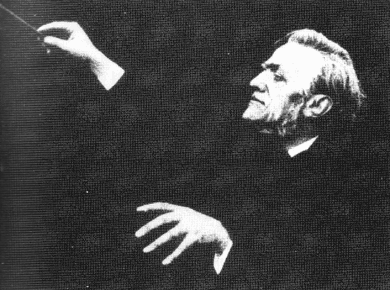Richard Wagner - a film biography
 Giuseppe Becce as Richard Wagner, 1913
Giuseppe Becce as Richard Wagner, 1913
"Richard Wagner - a film biography" featuring Guiseppe
Becce in the lead was filmed in 1913 on the occasion of Richard
Wagner's centenary and it is regarded as being completely preserved.
this opinion gets to a large extent confirmned when comparing
the sychronisation and tempo instructions in the partly preserved
piano score (the orchestra score is lost) with the film.
some music passages seem too long, though. it could well be that
some shots of the film are missing. others are too short. this,
in turn, is an indication for a rather liberal handling of tempo
by the background music.
at the beginning of the silent movie era one attempted to apply
as many as possible complete periods of a chosen composition for
accompanying film sequences. in order to synchronise the music
and the film, the music had to be matched with the duration of
the according scene. tempo and pitch of the music were trimmed
to fit the film's requirements as well as possible combinations
with sections taken from other pieces of music.
this might be one of the reasons why at that time film music was
considered frivolous.
not until many years later film composers began to write music
of irregular periods that was structured in such ways, that according
to the requirements of the length of the scene, motives or pieces
of a theme could be splitted off.
the producers originally planned to underlay the film with music
by Richard Wagner, an undertaking that was banned by the still
living Cosima Wagner who regarded the early cinema as vulgar and
inartistic. she likewise forbid the use of her father's, Franz
Liszt, music. in every sense Cosima tried to boycott the work
on the film.
as the producers were not allowed to use music by Wagner and Liszt
they had to find a way out of the dilemma. Guiseppe Becce, in
his real life a lawyer, suggested to compose a music that was
based on both their music, and being so alike that everybody would
immediately realise which composition was actually meant, but
at the same time the music should be so different from the original
that it could not be legally objected to. but indeed, the film
music accompanying Richard Wagner's youth Becce compiled from
orchestra classics such as Haydn, Mozart and Beethoven, and by
using quotations taken from operas by Meyerbeer, Rossini and others.
to begin with, a reconstruction of this film and its music of
which only fragments of a piano score seem to exist, raised the
question about the approach.
because today, more than 75 years after the death of the composers
Wagner and Liszt, one is legally free in the sense of the copy
right to use their music. but Frank Strobel and Bernd Schultheis
opted for the original film music, Becce's compilations and compositions,
because from today's point of view the film is a caricature of
Richard Wagner, and it contains much involuntary humour.
to underlay the film with the 'right' music would mean to excuse
it.
indeed, Frank Strobel and Bernd Schultheis intended, by emphasising
the humour in these pretentious pieces of music by Becce in an
ironically distanced orchestra adaptation (only a few origianals
stayed intact), to let also "non-wagnerians" experience
the film, and in particular to refer to the beginnings of film
music, the cinema itself. yet the film is not denunciated or ridiculed.
the re-instrumentation is based on the symphony No. 15 A-major
op. 141 by Dmitri Shostakovich.
many of the musical quotations adapted in this film had fallen
victim to Shostakovich's irony. a first impression emerged of
how to cope with such an instrumentational challenge.
bernd schultheis, summer 1992
|